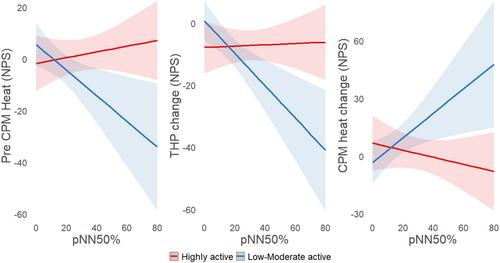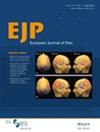Vagal tone, pain sensitivity and exercise-induced hypoalgesia: The effect of physical activity level
Abstract
Background
Vagal activity has analgesic effects that are attributed to exercise-induced hypoalgesia (EIH). High vagal tone and low pain sensitivity are reported in individuals who routinely exercise yet, their association is unclear. Furthermore, it is unknown if the heightened vagal tone following high physical activity predicts and intensifies EIH.
Methods
Fifty-one healthy participants (27 low–moderately physically active; 27 females) underwent a resting-state electrocardiogram followed by heart rate variability analysis. Pain measurements, including pressure (PPT) and heat (HPT) pain thresholds, ratings of tonic heat pain (THP) and conditioned pain modulation (CPM) paradigm, were conducted pre- and post-exercise on a cycle ergometer.
Results
The highly active group demonstrated higher vagal tone compared to the low–moderately active (root mean square of successive differences between R–R intervals: 63.96.92 vs. 34.78 ms, p = 0.018; percentage of successive R–R intervals that exceed 50 ms: 24.41 vs. 11.52%, p = 0.012). Based on repeated-measure ANOVA, the highly active group showed higher PPT at pre-exercise, compared to the low–moderately active group (382 kPa vs. 327 kPa; p = 0.007). Post-exercise, both groups demonstrated EIH, increased HPT (p = 0.013) and decreased THP ratings (p < 0.001). Linear regression revealed that only in the low–moderately active group, higher vagal tone was associated with more efficient pre-exercise CPM and a greater reduction in THP ratings post-exercise (p ≤ 0.01).
Conclusions
Highly active individuals demonstrate greater vagal tone and lower pain sensitivity but no greater EIH. Vagal tone moderates pain inhibition efficiency and EIH only in low–moderately active individuals. These findings suggest that physical activity level moderates the vagal–pain association via the endogenous analgesia system.
Significance
Highly physically active individuals exhibit greater vagal tone and reduced sensitivity to experimental pain, yet they do not benefit more from exercise-induced hypoalgesia (EIH) compared to low–moderately active individuals. Moreover, low–moderately active individuals with greater vagal tone exhibited more efficient endogenous pain inhibition and greater EIH, suggestive of the moderation effect of physical activity level on vagal–pain associations.


 求助内容:
求助内容: 应助结果提醒方式:
应助结果提醒方式:


